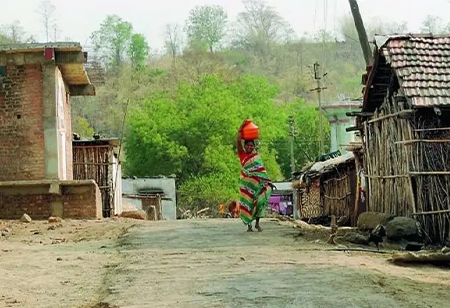
The Center's 'Vibrant Villages Plan' Could Brighten the Life in Indian Villages


The Vibrant Villages Program (VVP), a centrally sponsored scheme with a funding allocation of Rs. 4800 Crore, has been approved by the Union Cabinet, which is presided over by Prime Minister Narendra Modi, for the Financial Years 2022 -26. Complete village and block development along the northern border will raise the standard of living for those residing in the aforementioned border settlements. This will aid in enticing residents in border regions to remain in their homes and stop the exodus from these towns, improving border security.
Likewise, Amit Shah, the minister of home affairs and international cooperation for the Union, will begin a two-day trip to Arunachal Pradesh. He will interact with ITBP employees in Kibithoo by attending various activities. The Vibrant Villages Plan will also be introduced by the home minister in Kibithoo, a village near the China-India border.
What is a Vibrant Villages Plan?
The program will provide funding for the construction of vital infrastructure and the creation of livelihood opportunities in 19 districts, 46 border blocks, four states, and one UT along the country's northern land border. This will aid in achieving inclusive growth and preserving the population in the border regions. 663 Villages will be included in the program during the first phase. The program helps to identify and develop the economic drivers based on the local human, natural, and other resources of the border villages along the northern border, as well as the development of growth centers using the Hub and Spoke Model. This is done by promoting social entrepreneurship, empowering young people and women through skill development and entrepreneurship, maximizing the potential of local tourism, and developing sustainable ecosystems.
It is a scheme aiming for the comprehensive development of villages of blocks on the northern border, thus improving the quality of life of people living in identified border villages. This will help encourage people to stay in their native locations in border areas and reverse the outmigration from these villages, adding to improved security of the border. The scheme will provide funds for the development of essential infrastructure and the creation of livelihood opportunities in 19 Districts and 46 Border blocks, four states, and 1 UT along the northern land border of the country.
What is the Aim of the Program?
With the encouragement of social entrepreneurship, the Hub and Spoke Model is developed to drive growth and empower women and young people through business and skill development. It also aims to maximize the potential of local cultural, traditional, and historical knowledge and legacy. Sustainable eco-agribusinesses will be created based on the One Village, One Product tenet through cooperatives, SHGs, NGOs, etc. Gram Panchayats will assist the district administration in developing vibrant village action plans. There will be complete saturation of federal and state programs.
What is the Significance of the Vibrant Villages Program?
The program plans to encompass border settlements along the northern border with small inhabitants, poor infrastructure, and limited connectivity and frequently miss out on development benefits.
The program will contribute to increased border security by enticing residents to remain in their local communities in border regions and stop leaving these towns.
The plan will offer funding for the construction of necessary infrastructure and the creation of job opportunities. The program will make it possible for cooperative societies to establish and update the essential infrastructure, which will enhance the country's cooperative sector and expand its reach to the grassroots.
- It also aims to develop sustainable agricultural, dairy, and fishery cooperatives in each village.
- It will be supported by the National Bank for Agriculture and Rural Development (NABARD), the National Dairy Development Board (NDDB), and the National Fisheries Development Board.
- The plan aims to establish viable Primary Agricultural Credit Societies (PACS) in each uncovered Panchayat.
Out Migration from the Border Villages
Those who live in mountainous locations rely on subsistence farming, raising animals, and earning a living through small-scale trading and wage work. The government of India needs to pay more attention to the border villages, which results in inadequate connectivity, underdevelopment, and tough living circumstances, which prompts significant outmigration. A prime example is Uttarakhand, where there is a considerable exodus from the state's border regions because of unfavorable living conditions, terrible infrastructure, lack of connectivity, and inadequate health and educational services.
The army emphasized how border migration might have a significant impact on national security. It limits urban resources and, if unchecked, gives the hostile nation an opportunity to nibble on the territory. Outmigration from border regions is a problem for both internal and external security. The northeastern region of India and China share a long border, and the PLA is quickly building border communities for security. Settlements close to the border help the security forces and provide the nation with a psychological advantage. Also, because humans are the most precise surveillance equipment, watching the entire border, it minimizes the cost of surveillance.
The Union government unveiled a significant effort to strengthen security along the Line of Actual Control (LAC) with China by approving the addition of 9,400 personnel to guard posts along the Chinese border, approving the 4.1-km-long Shinku-la tunnel that will ensure all-weather access to Ladakh, and announcing incentives to persuade people to remain in isolated border villages. The Indo-Tibetan Border Police (ITBP) will receive a new sector headquarters in Arunachal Pradesh, which shares a long border with China, with seven new battalions totaling at least 9,400 soldiers.
Nearly 3,488 border crossings between India and China are patrolled by the ITBP in Himachal Pradesh, Ladakh, Kashmir, Uttarakhand, Sikkim, and Arunachal Pradesh. By taking this measure, the government will be better able to monitor its eastern border with China, which has claimed some areas of Arunachal Pradesh, and get quick access to crucial spots in Ladakh and Kargil during the snowy winter months.